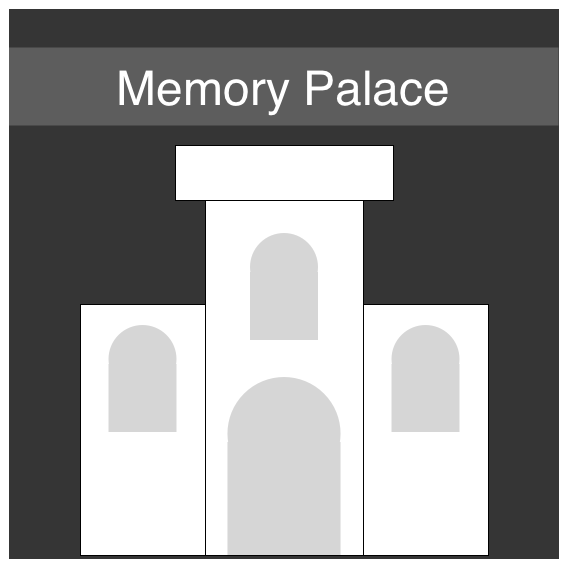- Toy
- Fish
- Airplane
- Temple
- Bells
- Day
- Garbage
- Cranberry
- Hole
- Nail
- Beach
- Radio
Because the list includes more than 7±2 items, it is going to overwhelm our verbal working memory; therefore, we need a strategy –a "memory hack" if you will– to memorize the entire list. For inspiration, let us turn our attention to antiquity, as the ancient Greeks already figured out a highly effective memory hack for missions such as these.
The Best Exotic Marigold Memory Palace
As the story goes, Greekguy was hosting party at his fraternity house. He stepped out for a breath of fresh air, and just as he left the house, the whole edifice came crashing down. Tragically, everyone at the party was killed. When the campus police arrived, they asked Greekguy to name the people who were in the house at the time. Amazingly, he was able to name every partygoer. He accomplished this amazing feat of memory by visualizing the house, mentally moving from room to room, and naming each person who was in each the room. He used each person's physical location (e.g., Hercules was on the couch, Athena was standing next to fireplace) as a memory aid [1]. In other words, Greekguy created a memory palace to help recall the enormous amount of information.Because our brains are probably organized in the same way as Greekguy's, the same memory hack is available to you and me. Let's give it a try. Think about a place you know extremely well. This might be your place of residence, or it might be the building where you work. Now, look back at the above list of words and physically place those items around your memory palace. You're lucky in the sense that I chose a bunch of words that are concrete nouns. For more abstract words, like "freedom" or "devious," we would need a way of representing those symbolically. For example, "freedom" could be represented by picturing an open window.
Time to get (redundantly) organized.
How or why does the memory palace work? This goes back to a contradiction that I raised in a previous post, in that sometimes adding information can make it easier, as opposed to harder, to commit something to memory. I think the simple explanation for why this is true is that the mind craves order. It is constantly trying to detect patterns and make sense of the world. If we can supply a strategy for bringing order to the world, then the brain is happy to cooperate.Another explanation is that our memory system enjoys redundancy. It helps to have multiple routes to the same item in long-term memory. If I try to brute-force the list of 12 items into long-term memory, then I have precisely one route to access that information. If instead I hang each item on a memory that already resides in long-term memory, then I have another route to rely on. Another way to say this is that the memory palace creates a memory cue, which can then help trigger recall. Cognitive psychologists call this "cued recall" (as opposed to "free recall," which refers to the brute-force approach).
If the hypothesis that "the brain craves order and redundancy" is true, then we might speculate that creating a narrative around the list is yet another way to hack memory. That is, instead of just placing the items around your memory palace, you could also take those items and create a little story about them. For example, you might start the story with, "The toy fish flew an airplane to the temple to ring the bells." Voila! You have already encoded the first five items merely by establishing a main character and the setting.
The STEM Connection
How is the memory palace useful in the educational arena? There are many applications. For example, suppose you are teaching an anatomy class and you want your students to learn all the bones in the hand and wrist. Or, you are teaching chemistry and you are covering the noble gases. How can you help them hack their memory? The first step is to have each student identify a memory palace that consists of a place that they can easily visualize. It could be their room at home or the classroom itself. Then, have them go through the process of mentally placing each bone around the room. Have them visualize each bone in its very own spot, as well as place bones that are physically connected in the body close to each other in their memory palace. The main idea is to add multiple routes to items that they want to store in long-term memory, and contextualizing the bones in a setting that they know well provides more opportunities for cued recall later on.Share and Enjoy!
Dr. Bob
For More Information
[2] If you think hacking memory is interesting, take a look at Moonwalking with Einstein. The author decides to win a memory competition. To do so, he trains himself to memorize random things, like decks of cards, very quickly. One of the methods that he talks about is the memory palace. Also, the author's TED talk is a good way to learn more about this topic.

